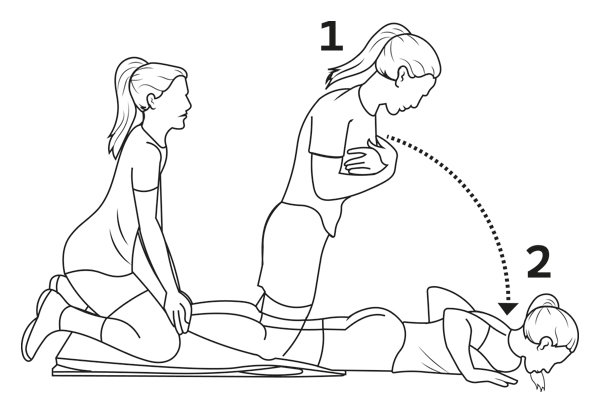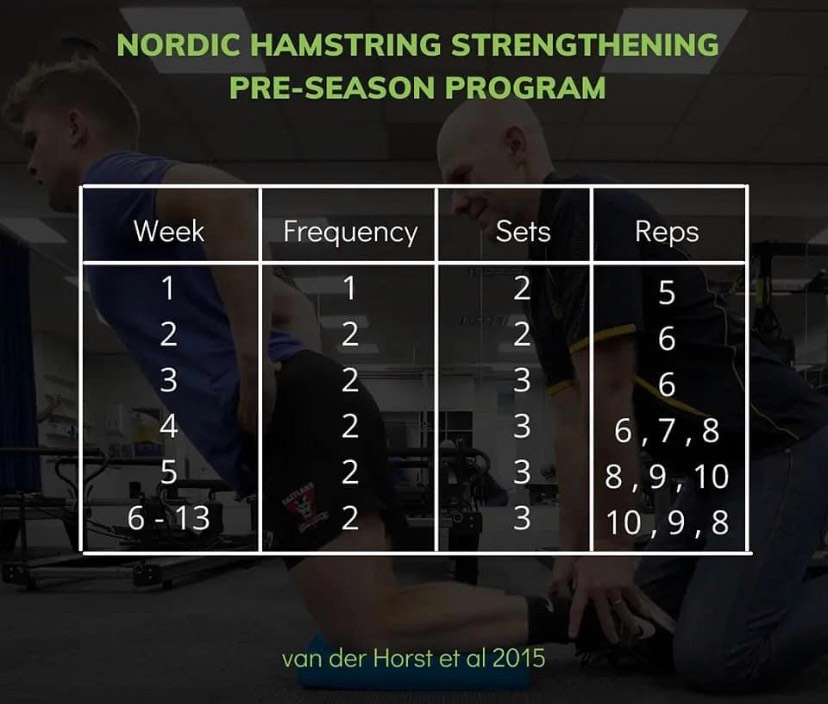
Nordic Hamstring Exercise (NHE). A proven exercise to prevent hamstring injury.
Hamstring tears are one of the most common injuries in soccer, accounting for 37% of all injuries (Ekstrand et al., 2011). The recurrence rate is also high, ranging from 12-33% (Hägglund et al., 2009). Several factors increase the risk of a hamstring injury, including age, player position, previous injuries, muscle architecture, fatigue, flexibility, core stability, and strength (van der Horst et al., 2015).
The highest risk factor for hamstring injuries is acceleration or high-speed running, which accounts for 53% of cases (van der Horst et al., 2015). During the late swing phase of high-speed running the hamstring muscles are suboptimally stretched. It then has to quickly decelerate the motion of knee extension. The faster the running speed, the greater the force placed on the hamstrings. A lack of hamstring eccentric strength is strongly associated with hamstring tears (Croisier et al., 2002).
The average recovery time from a hamstring injury ranges from 17 to 90 days (Silvers-Granelli et al., 2024). Due to the significant downtime, considerable effort and research have focused on reducing the risk of hamstring injuries.
One effective method to mitigate hamstring injury that has been researched extensively is the Nordic Hamstring Exercise (NHE). Studies by van der Horst et al. (2015) and Silvers-Granelli et al. (2024) have shown that the NHE significantly reduces the risk of hamstring injuries in soccer players. In Silvers-Granelli et al.’s study, incorporating the NHE into the FIFA 11+ program reduced the risk of hamstring injuries by 63% compared to a control group that did not participate in the program. In this study, they included men’s soccer teams from America’s National Collegiate Athletic Association Division 1 and 2. Another study by van der Horst et al. found that high-level amateur soccer players in the Netherlands who performed the NHE decreased their relative risk of hamstring injury by 57% compared to those who did not perform the exercise.
The population characteristics of the studies are elaborated below:
1. Silvers-Granelli et al. (2024): Men’s team from the National Collegiate Athletic Association division 1 and 2. The study did not specify the average age of the players. However, the average age of players who sustained a hamstring injury was reported as 21 years old.
2. van der Horst et al. (2015)
Dutch male amateur soccer players aged 18 to 40 years.
The dosages for the NHE suggested by each studies are listed below:
1. Silvers-Granelli et al. (2024)
The NHE was performed together with other warm-up exercises within the FIFA 11+ program. The dosage for the NHE specifically was 1 sets of 3-5 repetitions in the beginner group, 7-10 repetitions for the intermediate group, and 12-15 repetitions for the advanced group. The intervention group would perform the FIFA 11+ program 2-3 times per week before their training sessions.
2. van der Horst et al. (2015)
In the intervention group, the individuals performed the NHE by following the Week 1-5 program (build-up phase) and during the season they would follow the Week 6-13 (maintenance phase) program. The NHE was done after training and before their cool-down session.

In summary, incorporating the NHE into soccer training is highly recommended for players. The reasons are clear: it significantly lowers the risk of hamstring injuries, preventing players from missing important matches during the season.
If you want a video to learn how to perform the NHE, send us a message with the words “Nordic Hamstring Exercise.” We will reply within 24 hours.
Reference Lists:
Croisier, Jean-Louis et al. “Hamstring Muscle Strain Recurrence and Strength Performance Disorders.” The American journal of sports medicine 30.2 (2002): 199–203.
Ekstrand, Jan, Martin Hägglund, and Markus Waldén. “Epidemiology of Muscle Injuries in Professional Football (Soccer).” The American journal of sports medicine 39.6 (2011): 1226–1232.
Hägglund, M., M. Waldén, and J. Ekstrand. “Injuries among Male and Female Elite Football Players.” Scandinavian journal of medicine & science in sports 19.6 (2009): 819–827.
Silvers-Granelli, Holly et al. “The 11+ Injury Prevention Programme Decreases Rate of Hamstring Strain Injuries in Male Collegiate Soccer Players.” British journal of sports medicine(2024): bjsports-2023-107323.
van der Horst, Nick et al. “The Preventive Effect of the Nordic Hamstring Exercise on Hamstring Injuries in Amateur Soccer Players: A Randomized Controlled Trial.” The American journal of sports medicine 43.6 (2015): 1316–1323.








